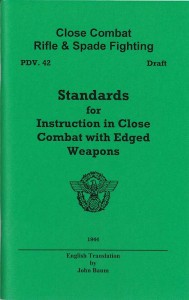Review by Jim Dickson
 Standards for Instruction in Close Combat with Edged Weapons; A WW2 German Army Manual translated by John Baum; 92-pages. Available from: John A. Baum; 5678 State Rt. 45, Dept. TGM, Lisbon, OH 44432; online at: GermanManuals.com. Price: $18, including shipping.
Standards for Instruction in Close Combat with Edged Weapons; A WW2 German Army Manual translated by John Baum; 92-pages. Available from: John A. Baum; 5678 State Rt. 45, Dept. TGM, Lisbon, OH 44432; online at: GermanManuals.com. Price: $18, including shipping.
For anyone wanting to master the use of the rifle and bayonet this 92-page WW2 German Army manual is the best book you can buy on the subject. I have read all the US manuals on the subject back to WW1 and they pale by comparison. The American military pugil stick training has as much relation to real bayonet fighting as a kid with oversized toy boxing gloves has to making Gene Tunney’s boxing moves. All you can do with that oversized Q-Tip is to learn to fight with pugil sticks. If you really want to master the art of using the rifle and bayonet, this is the book for you.
Every move and every counter move is delineated in clear detail in the tradition of the great medieval German sword fighting manuals. Practice between two soldiers is laid out with each soldier’s role choreographed like a dance. Continued practice with this manual will produce an accomplished bayonet fighter capable of meeting any challenge thrown at him. I cannot say that about any other manual on the subject that I have seen.
The book continues with the use of the long spade and the short spade in combat. Use of the shovels against a rifle and bayonet are covered in the same detail as before. It should be noted that the German short spade was better suited for hand-to-hand combat than the entrenching tools of other nations by design. It functions more like a fighting hatchet in the hand than its rivals do.
All these techniques were well proven and validated in WW2 combat by Hitler’s soldiers. They saw a great deal of use on the Eastern Front as the Soviet human wave assaults reached the German lines where the superior skill of the German soldat was pitted against the hordes of Russian peasants. The Germans gave a very good account of themselves against these impossibly high odds and how they did it is worth study.
Today’s crop of assault rifles are less suitable for bayonet fighting than the old bolt action rifles of the past so we will not see another work of this scope on this subject again. This is the definitive work on bayonet fighting and will remain so.



